Fighting Counterfeit Fashion Online
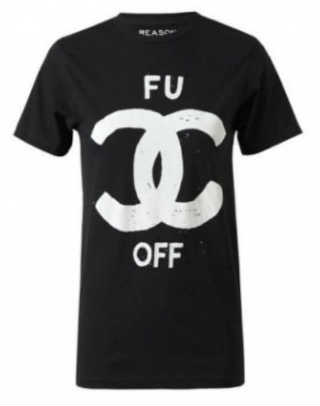
They say that ‘imitation is the sincerest form of flattery’ but is it really? Perhaps, when it is tastefully done in an obvious and open manner and when the imitator isn’t trying to portray themself as your brand.
A good example of this were the ‘Celine Dion’ and ‘Chanel’ t-shirt spoofs sold at Browns last year which happened to even be a hit with the celebs of the world because of the humour incorporated into the graphics eg: ‘FUCC OFF.’
Imitation is not okay however, when counterfeit website’s impersonating your brand are creeping onto the first page of search results for your own brand name and are deceiving customer’s into thinking they are making a genuine purchase.
If You Haven’t Considered the Counterfeits of the World Your Competitor – You Should!
It’s easy to become complacent as a reputable brand, especially in high fashion because if your brand is dominating the catwalk and forward fashion trends, it’s easy to think ‘well people know who we are, they know our brand,’ but unfortunately that doesn’t mean that they are going to venture to your store to make a purchase and the problem is, that counterfeit e-commerce sites are getting smarter and that’s how they are featured on the first page of Google and unfortunately, catching innocent shoppers out. Let’s take a look at just how serious this is, especially as the search for high fashion brands online is most likely to soar following London, New York and Paris fashion weeks.
The Victim – Christian Louboutin
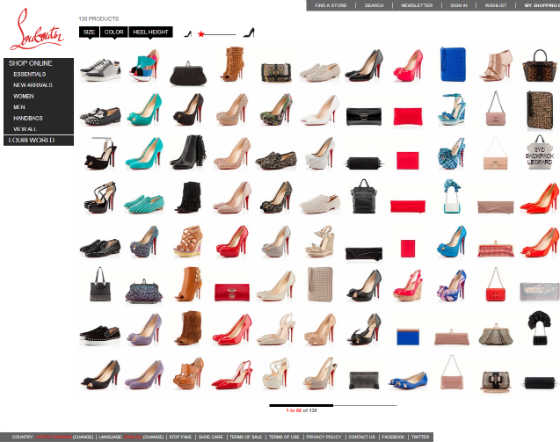
With his trademark red soles and sky high heels, Christian Louboutin is definitely leading the footwear market as one of the most sought after, and drooled over brands in the fashion industry so it is no surprise that there are counterfeit websites out there trying to reap the benefits of his brand name and style. On page 1 of Google UK, the websites ranking at positions 4, 5 and 6 are not genuine Christian Louboutin retailers. When a website loads up with just a load of text it’s obvious to spot an untrustworthy site, but when the site has the logo, the branding, the products and the content is written as if they are the brand, it can be a little harder to judge whether they are a genuine representative of the brand or not.
How They’ve Done it
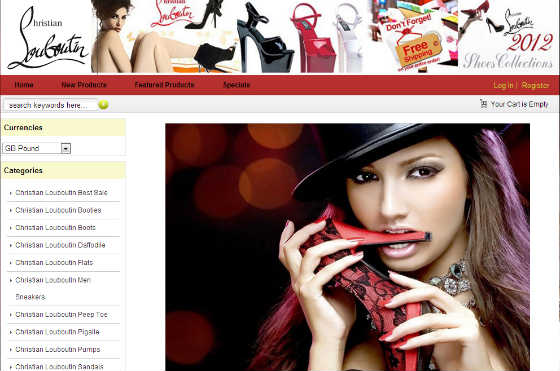
Basically, they have been smart. They have completely optimised their pages with branded keywords and optimum search terms within their content, their domain names and also their Meta Data.
This counterfeit website’s Title Tag is as follows:
“Christian Louboutin Online Store, Christian Louboutin Outlet, Christian Louboutin UK, Cheap Christian Louboutin On Sale”
Whilst this is A LOT of keyword stuffing in the Title Tag, they have at least optimised their website with keywords that are likely to be searched for by potential shoppers.
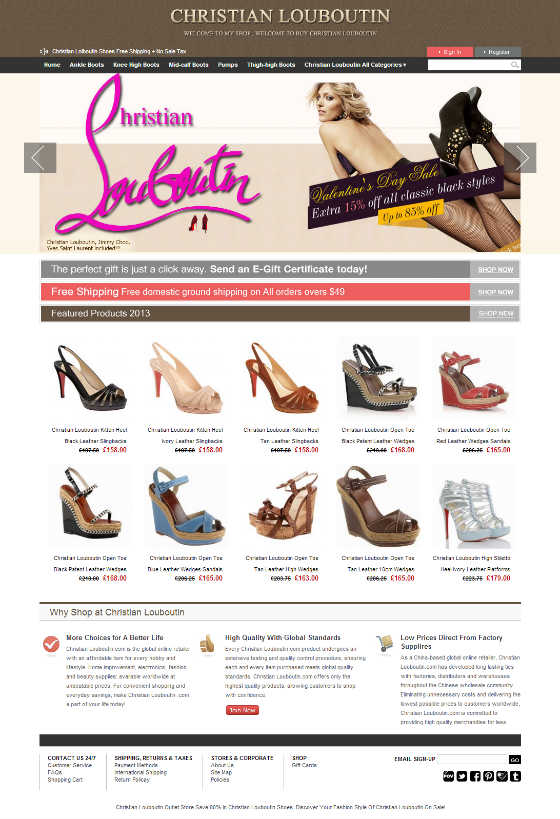
Unfortunately, I cannot say the same for the official UK Christian Louboutin website who’s Title Tag is as follows:
“Christian Louboutin – Online Boutique”
Alas, this counterfeit site is digging their heels in even further to mark their territory in SERP’s (search engine results pages) by implementing a keyword rich, optimised Meta Description:
“Christian Louboutin Outlet. Save 70% on Louboutin Pumps at Louboutin Shoes Online Store. Christian Louboutin Outlet Store offer luxury Louboutin Boots for your sincere selection.”
Monsieur Louboutin’s UK site does not have a Meta Description at all. Tut tut!
Lastly, they have plastered their onsite content with branded keywords and even optimised their site for the official domain name ‘Christian Louboutin.com.’ Search engines will crawl the content on your website which is why every page on your site should have at least 100 characters of text. As Alex Novakovic has recently discussed, content is not all about blogs!
You Can’t Avoid it, you NEED to Optimise your Website
These two small but important factors are proof alone that your brand is not enough to get you onto the front page of search engines nor is it enough to protect your brand from the copy cats out there. If these counterfeit website’s continue to optimise their website well (let’s not get onto their web design) then your brand will continue to be threatened online no matter how much money you turn over or how much you dominate the catwalk.
Protect your Customer’s – Keep them Informed
UGG is a brand that is only too familiar with being a victim of counterfeit design and brand impersonation but, they decided to fight back against fashion fraudsters.
UGG have decided to approach the issue of counterfeit UGG replica’s being sold online by launching a ‘Counterfeit Protection’ campaign on their website which is visible from their homepage.
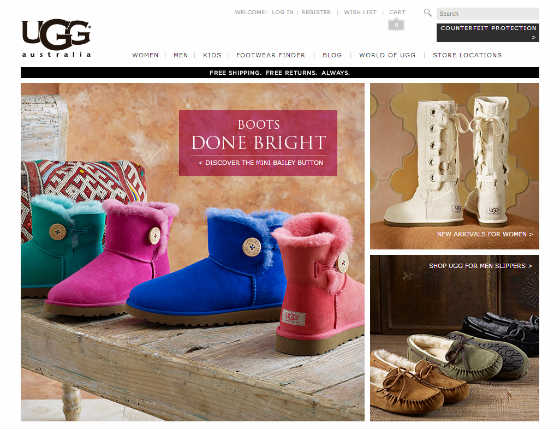
In previous years, page one of Google UK featured, as you would expect, UGG Australia ranking at position 1 but this was then followed by counterfeit websites ranking beneath them when really, they should have dominated the entire page.
How UGG have Decided to Fight Back
UGG’s tactic is one to learn from. By making your customer’s and brand followers more aware of what to look out for online in order to avoid purchasing counterfeit products, the more likely they are to re-visit your site be this for further advice, finding official stockists of your products or to actually make a purchase.
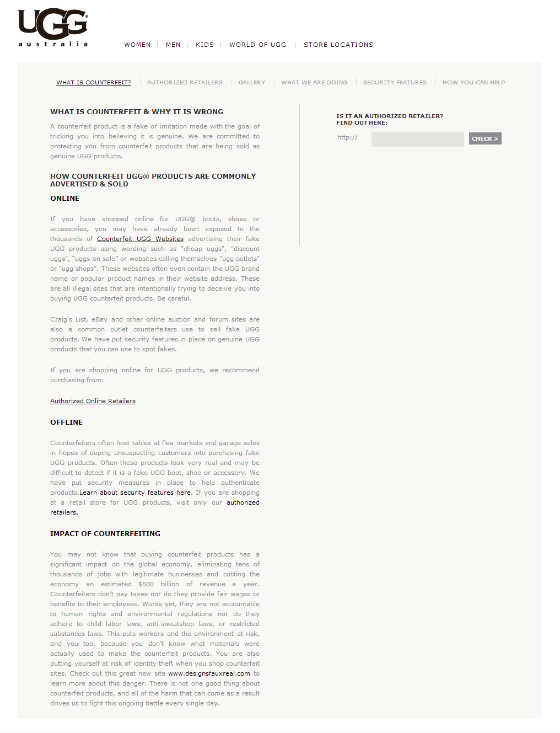
By creating their ‘Counterfeit Protection’ page, UGG have been able to optimise their website for the keywords that impersonators have been dominating the search engines with in order to compete with them. Key search terms such as ‘Cheap , outlet or Discount .’ Their Title Tag for this page is:
“Warning: “UGGS on Sale”, “Cheap UGGs” & Discount UGG Boots”
UGG have even gone as far as to start listing the counterfeit domain names on their site but of course have been clever enough not to link to any of these websites.
How to Spot a Counterfeit Website
Counterfeit websites are advancing their methods and making themselves look more and more genuine, but there are a few giveaways you can find to help you steer clear of fraudulent transactions:
- Instinct Your instinct is a great indicator in determining whether something feels right or not. If something appears to be a little too good to be true, unfortunately it usually is
- Look Use your eyes! They are powerful things. If you are looking at purchasing a brand then you should know them quite well. Look at the images being used on the site, do they appear to be genuine? Do they look cheap, blurry or copied? Is the logo correct?
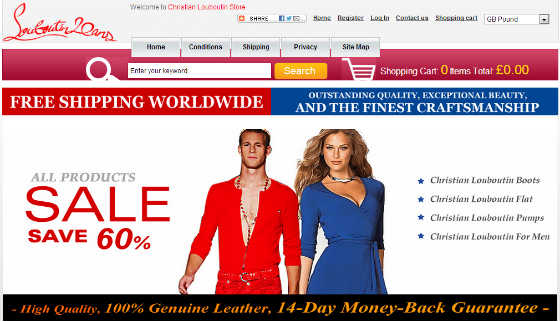
- Read Look at the content on the page, does it read well? Are there spelling mistakes? If you see a website that has a ‘HOTKEYWORDHERE’ section then it’s probably not a genuine site for the brand you are looking to buy as the person that would let that mistake happen on a live site, would be scorned!
- T&C’s, Privacy Policy, Delivery, Contact Us Look at these pages. Is there an address listed on the website? Do they have UK based courier’s or delivery methods listed? If a site says that you cannot return an item because of an error on your part eg: Wrong Size ordered, I wouldn’t trust them. Also, if the site claims to be tax free they are probably an international company but that does not mean that customs charges will not be applied to you upon delivery in the UK. Try and find out where they are shipping from if you can
- Payment If a website says that they offer PayPal as a payment merchant but then only provide you with an option to enter a credit card/debit card on their site, abandon your shopping cart. Look at their payment methods in advance, do the logo’s look genuine? Are they methods you have heard of? Do you have to sign up to anything?

